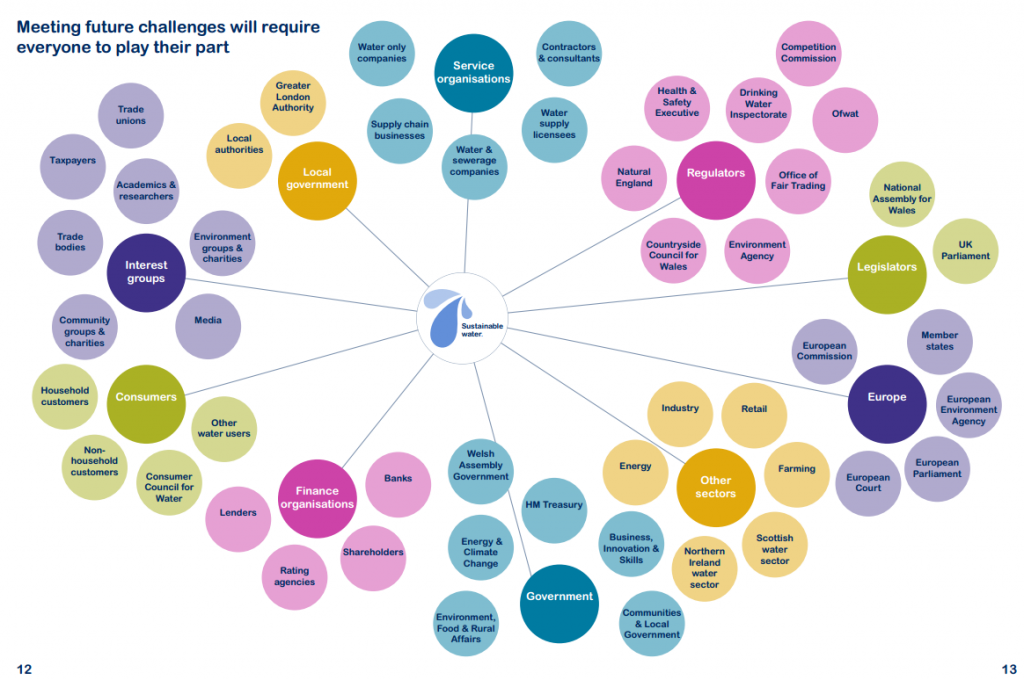If you’re interested in learning more about how the water industry works, Ofwat’s pages on regulating the industry provide information on the industry itself, what water and sewerage companies have to do to keep their licences, and how they are regulated. You can also find links to the water companies’ annual reports, including their ‘key performance indicators‘ The section of Key Indicators explains these (also called KPIs): it includes a link to a spreadsheet (XLSX) which does the following:
Deciphering jargon
The sheet marked ‘Customer experience’, for example, explains that Service incentive mechanism (SIM) means “The level of customer concern with company service and how well the company deals with them.” Likewise ‘Security of supply index (SoSI)’ means:
“the extent to which a company is able to guarantee provision of its levels of service for restrictions of supply. The indicator measures security of supply for two scenarios (where relevant) – under dry year annual average conditions and peak demand conditions.”
Explaining the legal obligations
Row 5 on each sheet lists the “Obligation” under each category, often including specific parts of regulations that companies must abide by. The category “Water supply interruptions” contains quite a lengthy list of these:
Water Supply and Sewerage Services (Customer Service Standards) Regulations 2008 (The GSS Regulations) – Regulation 8. General water supply duties include: • Section 37 – general duties of water undertakers (companies must maintain an efficient and economical system of water supply); • Section 52 – domestic supply duty; • Section 55 – non-domestic supply duty; • Section 57 – duty to supply water for fire fighting; • Section 59 – public purposes supply duty; • Section 63AC – interim duty of water undertaker: domestic and non-domestic supply; and • Sections 66A and 66C – wholesale water supply duties. Supply duties can be overridden in certain circumstances, including: • Section 60 – disconnections for necessary works; and • Section 75 – prevention of damage and contamination.
Likewise, the sheet ‘Environmental impact’ details obligations under “Environmental laws including the Environmental Permitting (England & Wales) Regulations 2010”
Explaining scores
The sheets also explain how scores are calculated. If you read that Severn Trent Water’s ‘Water supply interruptions’ score was 0.61, for example, what does that mean? Well it means that on average every property supplied by that company was without water for 0.61 hours in that year. But you can also read that
“This is a new measure that was not included as a final determination output at the 2009 price review. The companies should specify their expected performance and the tolerances they will apply.”
In other words, the companies set themselves this target (notably, while Severn Trent’s figure of 0.61 shown above is considered ‘below target’, South West Water and Wessex Water’s figures of 0.62 and 0.60 respectively are ‘in line with or better than expected’. The only other company to give itself a red rating is South East Water, whose 0.36 hours of interrupted service is still lower than seven other companies. There may be local contexts to these variations to investigate first).
Finally, for an overview of the wider water industry, the diagram from Ofwat’s strategy document (PDF, page 12-13) gives an excellent overview of the different bodies that may be relevant to any question (click for full size version).
If you use these resources to look into your own water company’s performance – or find any other useful resources – please get in touch.

